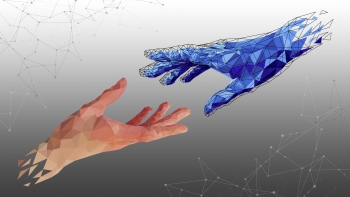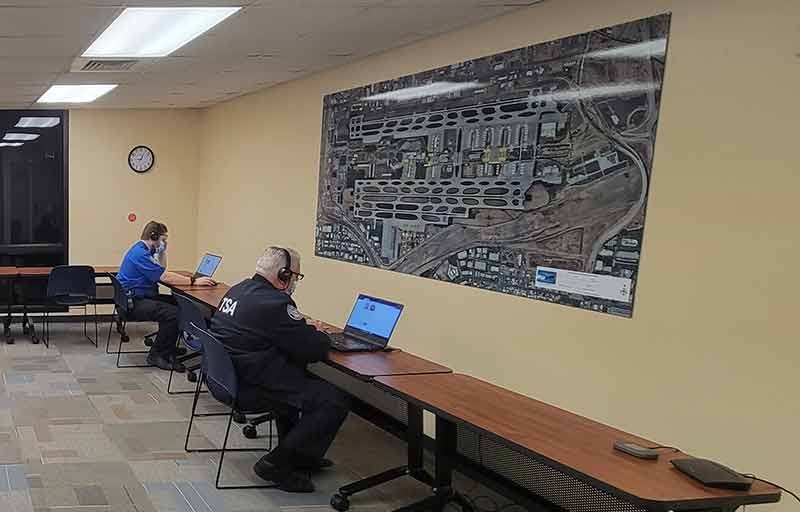Does the Super Bowl result in an increase in human trafficking? – ASU News

February 7, 2023
ASU expert, who teaches Fundamentals of Human Trafficking class, weighs in
January was Human Trafficking Awareness month. The Super Bowl, which historically has been linked to an increase in sex trafficking, will be played at State Farm Stadium on Feb. 12.
What better time, then, to check in with Samantha Calvin, an instructor in Arizona State University's Edson College of Nursing and Health Innovation.
Calvin has studied human trafficking for more than a decade and teaches a Fundamentals of Human Trafficking class that is embedded within the college.
ASU News talked to Calvin about human trafficking, the misconceptions surrounding Super Bowl activity, the role of social media and what people should or shouldn't do if they believe they've encountered trafficking.
Editor's note: The following interview has been edited for length and clarity.
Question: Let's start with this. How would you describe human trafficking?
Answer: So, I always start my first day of class asking my students a question: What do you think of when you think of a prostitute, and what images come to mind? I think that exposes the fact that we all hold stereotypes about what people think trafficking should look like and what a trafficker looks like. I tell my students that it often doesn't meet our misconceptions.
I think, to the average person, they can drive past someone in some of the major areas of Phoenix where we know trafficking is occurring, like on 27th Avenue, and they can just think, “This person is using substances, this person is a “prostitute.” I think what they're missing behind the scenes is that there's likely a trafficker or pimp nearby who is controlling that situation.
Anyone who's under the age of 18 who trades sex for anything of value, whether that's a phone or a cheeseburger or a place to stay, that is trafficking. End of story. And if you're over 18, there has to be some form of, at least federally, the definition of forced coercion or fraud present.
Q: The Bureau of Justice Statistics released a report in October of 2022 stating there was a 62% increase in the number of persons referred to U.S. attorneys for human trafficking offenses in 2020 compared to 2011. Is that because human trafficking is on the rise, or is there a more concerted effort to prosecute offenders?
A: I think it's because we're more aware of it now. When I started working in this field around 2010 it wasn't a buzzword. There was no Human Trafficking Awareness Month like there is now. We finally have human trafficking-specific units and dedicated people in law enforcement who are trained to work in this area. Also, I think there's just a better community awareness and sense of what it looks like. We're realizing that not everyone who is on the street is choosing to be there. I think working through that kind of victim lens, that trauma-informed approach, is why cases are moving forward. I also think there might be some increase in (trafficking) just in the last 10 years with social media. The access of the internet has made it a lot easier for traffickers to reach out to potential victims.
Q: Expand on that. What is the role social media now plays in human trafficking?
A: I was just listening to a podcast about kids getting fentanyl off Snapchat, and should social media companies be held liable and responsible. I think it's going to be a huge conversation with trafficking shortly, too. Right now, I'm looking at a study that says certain hashtags are associated with this world of trafficking and people who are being exploited. I tell my students and show them that you can find a trafficker's profile on Instagram in like 15 seconds. It does not take any time at all. So I think social media plays a huge role.
Q: There's a belief that events like the Super Bowl create an increase in sex trafficking. Is that actually the case?
A: It's not the Super Bowl that creates a spike in trafficking or that trafficking is directly linked to these events. Men who are women buyers and come to a new city for an event or a conference, the chances of them buying sex in that city are pretty high. So, it's not the Super Bowl or the Barrett-Jackson Auction or the Phoenix Open that creates trafficking. It's the people who already are buying sex and they come here and they buy sex here.
There are such things as circuit girls, who are transported from city to city sometimes in order to meet expected demand. But we're not saying the Super Bowl in and of itself is driving trafficking, but more people, more money and more power moving into a city. You're going to have increases in sex buying.
Q: What are you teaching students in your Fundamentals of Human Trafficking class?
A: What I want them to take away from it is, I think that human trafficking is a problem in our community that they can do something about as both future health care providers and just community members living in society — things to look for, what to do if they suspect something. I bring in a ton of different guest speakers so that they can hear about trafficking through the lens of different people who interact in this area, like law enforcement and journalism and health care, people on kind of the front lines. They also get partnered with a community nonprofit so they can work in helping them solve one of their problems or create educational materials for different populations.
Q: You also have an online course for health care providers. Reportedly, 70% of trafficking victims have some sort of interaction with a health care provider. How can those providers help the victims?
A: When I started working with girls who had been trafficked, that was a common theme, that they had been seen by a health care provider — oftentimes brought in by their trafficker — whether it's the emergency room or urgent care, and then they leave unrecognized. That's not to blame the health care provider, because they're often short on time. They're doing what they can. But there are things I teach in the course of what to look for, some of the red flags, how to ask better questions if that is suspected. I think that's just a big area where we can make a difference, because there's not a lot of opportunity to interact with people who might be at risk or who are actively being trafficked.
Q: Aside from health care providers, what should someone do if they suspect human trafficking?
A: If something looks off, doesn't feel right or you get a gut feeling about something that looks like trafficking, calling the National Human Trafficking Hotline number is probably the easiest go-to because the folks who are answering those calls have had 60 to 80 hours of training. They know how to refer back to local law enforcement or local resources. Also, if there's ever an interaction with (a victim), provide that number and say, “If you ever need this, this is the number to call.”
Q: And what shouldn't people do?
A: If it's a dangerous situation, don't try to approach someone, especially if they have a trafficker who is nearby and might be suspecting law enforcement or an authority figure. That can put the victim in more danger. So it's not always the appropriate response to intervene, unless it's a safe situation.
Top photo courtesy iStock

February 7, 2023
If you're in the habit of using Siri to search the web, having Alexa turn on your lights, creating unique portraits with the Lensa app or writing with the help of ChatGPT, you are interacting with artificial intelligence (AI).

AI is a growing presence in our lives and has great potential for good — but people working with these systems may have low trust in them. One research team at Arizona State University's Center for Accelerating Operational Efficiency is working to address that concern by testing a tool that could help government and industry identify and develop trustworthy AI technology.
Artificial intelligence is a computer system able to perform human-level tasks like summarizing information, understanding images or speech, or making decisions. It shows up in many everyday technologies.
It's also increasingly used in sectors like health care, helping medical experts make diagnoses and discover new drugs faster; in finance, where automated investing makes navigating the stock market easier; and in transportation, powering self-driving cars to navigate busy roads.
Making these innovations possible, however, requires people to work together with AI. And while most people may not harbor active suspicion against AI, they may have low trust, much like you might have for a complete stranger. If an AI system diagnosed you with a disease, for example, would you pursue treatment right away or would you seek out a second opinion from a human health professional?
“Things that would lead to low trust are if the technology's purpose, its process or its performance were not aligned with your expectations,” says Erin Chiou, an assistant professor of human systems engineering in The Polytechnic School, part of the Ira A. Fulton Schools of Engineering.
Certainly there are many legitimate reasons to be critical of AI as we continue to develop this technology. The following are just a few ways AI can hinder, rather than help, people:
- AI algorithms trained with biased data sets can perpetuate discrimination. For example, in the housing industry, AI systems that screen tenant and loan applications have been known to skew against people of color.
- AI is unable to follow social conventions unless programmed to do so. For example, an AI system may know critical information but not share it with its human counterparts unless specifically asked.
- Privacy issues are a constant point of concern when it comes to AI, such as apps that track your data in order to feed you customized ads and content.
As a result of these and other challenges, in October 2022, the White House issued the “Blueprint for an AI Bill of Rights,” which gives guidance on how to implement AI technology in a way that protects the rights of the American public.
Problems can also arise when people develop or acquire an AI system that doesn't work in the best interests of the users, or when high expectations of the technology lead to catastrophic security breaches, adds Chiou.
“In some ways, a critical eye towards technology can be healthy. That's not to say that we should never use technology because of its flaws, but having a critical eye is and should be empowering. If you look at the bigger picture, people still provide a lot of value as a workforce that will be very difficult for AI to replace,” says Chiou, who is also a researcher in the Center for Accelerating Operational Efficiency.
Despite these shortcomings, AI has an immense power for good when used responsibly. Chiou points out that AI has enabled upscaled economic activity that has improved the quality of life for many, such as rapidly building critical infrastructure like highways and energy grids, as well as providing more informed decisions in health care.
Related: AI-equipped robots will be essential teammates as humans explore outer space
It also plays a role in our national security. Regardless of whether the United States embraces AI technology, other countries will — countries with possibly different values than our own.
“If you believe that our values in the U.S. will lead us to do more good than harm to the world, then we have to remain competitive in these high-tech areas like AI,” Chiou says.
To that end, Chiou is working on a project that will help U.S. government and industry acquire AI technology that people will feel confident in using and work with more smoothly. Funded through the U.S. Department of Homeland Security, the research group is testing whether a new tool effectively measures the trustworthiness of AI systems.
The tool, called the Multisource AI Scorecard Table (MAST), is based on a set of standards originally developed to evaluate the trustworthiness of human-written intelligence reports. It uses a set of nine criteria, including describing the credibility of sources, communicating uncertainties, making logical arguments and giving accurate assessments.

To test whether MAST can effectively measure the trustworthiness of AI systems, volunteer groups of transportation security officers interacted with one of two simulated AI systems that the ASU team created.
One version of the simulated AI system was built to rate highly on the MAST criteria. A second version was built to rate low on the MAST criteria. After completing their tasks with one of these systems, the officers completed a survey that included questionnaires on how trustworthy they thought the AI was.
The Transportation Security Administration's federal security directors from Phoenix Sky Harbor International Airport, San Diego International Airport and Las Vegas Harry Reid International Airport each organized volunteer officers to participate in the study.
The Center for Accelerating Operational Efficiency has a history of working with the TSA. Previously, Chiou's team participated in piloting a new AI-powered technology at one of Sky Harbor's terminals. The new screening machine uses facial recognition to help a human document checker verify whether a person in the security line matches their ID photo. That study showed that the technology increased accuracy in screening. The current project is testing whether new, MAST-informed features will affect officers' trust perceptions and performance with the technology.
Related: ASU researchers' smart cameras are monitoring traffic with AI to make city streets safer
“The Transportation Security Administration team in Arizona has had the privilege to partner with ASU and the Center for Accelerating Operational Efficiency for the past several years. We are particularly excited to have the opportunity to partner with them on this project involving artificial intelligence,” says Brian W. Towle, the assistant federal security director of TSA-Arizona. “With the use of AI rapidly growing across government and private sector organizations around the globe, there is significant value in increasing public awareness and confidence in this technology.”
For the fieldwork phase of the current project, the officers viewed images of people and ID photos as if they were in the document checker position. The simulated AI system gave them recommendations for whether the images and ID photos matched. The officer makes the final decision about whether to let a person through the line, which is why their trust in the AI recommendation matters.
AI-powered face matching technology is already in place in at least one terminal of Sky Harbor, Chiou says, as well as similar systems in airports in the United Kingdom and Canada. While it may take a while for airports nationwide to acquire this technology, we are likely to encounter it more and more in the future as we travel.
If the ASU team is able to show that the MAST tool is useful for assessing AI trustworthiness, it will help in building and buying systems that people can rely on, paving the way for AI's smooth integration into critical sectors, protecting national security and multiplying its power for positive impact.
“The next steps for the tool would be for people in technology development or acquisition who could then use that tool to help them create or evaluate technology that would be trustworthy,” Chiou says.
This “Eyes on Trafficking” story is reprinted from its original online location.
 ABOUT PBJ LEARNING
ABOUT PBJ LEARNING
PBJ Learning is a leading provider of online human trafficking training, focusing on awareness and prevention education. Their interactive Human Trafficking Essentials online course is used worldwide to educate professionals and individuals how to recognize human trafficking and how to respond to potential victims. Learn on any web browser (even your mobile phone) at any time.
More stories like this can be found in your PBJ Learning Knowledge Vault.
EYES ON TRAFFICKING
This “Eyes on Trafficking” story is reprinted from its original online location.
ABOUT PBJ LEARNING
PBJ Learning is a leading provider of online human trafficking training, focusing on awareness and prevention education. Their interactive Human Trafficking Essentials online course is used worldwide to educate professionals and individuals how to recognize human trafficking and how to respond to potential victims. Learn on any web browser (even your mobile phone) at any time.
More stories like this can be found in your PBJ Learning Knowledge Vault.

